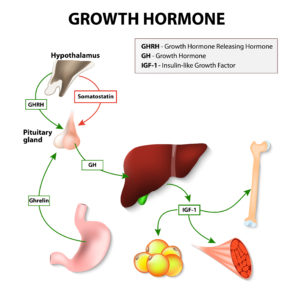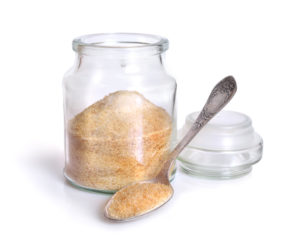How to Increase Growth Hormone Naturally: 15 Tactics
 Human Growth Hormone is widely considered to be the linchpin of youth hormones. It rejuvenates skin, bone, cartilage, and muscle tissue. It also burns body fat. Here are 15 tactics to increase growth hormone naturally, which might help you stave off some aging itself.
Human Growth Hormone is widely considered to be the linchpin of youth hormones. It rejuvenates skin, bone, cartilage, and muscle tissue. It also burns body fat. Here are 15 tactics to increase growth hormone naturally, which might help you stave off some aging itself.
Growth Hormone: What is it?
Human growth hormone (somatotropin) is a single-chain polypeptide consisting of 191 amino acids. It’s produced and released naturally by the anterior pituitary gland. GH stimulates cell growth, cell reproduction, and cell regeneration.
It’s an anabolic hormone; not as anabolic as testosterone, but does help stimulate muscle strength and hypertrophy.
Growth hormone triggers the release of another hormone by the body called insulin-like growth factor-1 (IGF-1). This hormone is produced in the liver and is similar in molecular structure to insulin (as the name implies).
Many of the benefits of boosting growth hormone are technically due to the resultant higher levels of IGF-1. This is important to know because IGF-1 levels are less fleeting and much more stable than growth hormone.
Consequently, if you want to have your growth hormone level tested, you’d actually get a more accurate reading by having your IGF-1 level tested.
… But more about all that later.
Let’s delve into the details of how to increase growth hormone naturally, exploring how we might reap the benefits of both acute and long-term higher levels of this ‘ebb-and-flow’ youth hormone.
Natural Growth Hormone’s Unanswered Questions
Let’s be honest about natural growth hormone. We keep hearing that it drops as we age.
Then we find out we can stimulate its release with better body composition and certain tactics. We’re told that the resulting higher GH levels can slow down aging.
But any thinking person understands that this depends on to what degree aging is an effect of reduced growth hormone and to what degree it’s a cause of it. Maybe it’s both. But not even the PhD’s have broken down that ratio. 
Another question is whether acute boosts in endogenous GH work in relative correspondence to the age related decline in average levels of the hormone. Many studies on acute stimulation of GH have been done only on younger subjects. Some have been done using middle-aged and older ones. For studies in which only young subjects were used, we can only assume the positive effect transcends age.
In a nutshell, endogenous growth hormone as it relates to aging is still somewhat a mystery.
Age aside, it’s also not known whether periodically stimulating higher GH pulses results in higher average levels.
We know that some long-term changes in physiology, such as reduced body fat, result in higher average GH levels.
That’s because the opposite condition, holding excess body fat, results in reduced GH levels.
But we don’t know if one-off methods, even done regularly, raise our average growth hormone levels.
For example, if I do a set of wind sprints with nothing in my stomach but 20 grams of creatine, I might send my growth hormone levels into the stratosphere for an hour or two.
If I do this regularly, we might assume it will greatly raise my average growth hormone levels.
But that’s a major assumption. Given the body’s penchant for homeostasis, we don’t know for sure.
How to Increase Growth Hormone Naturally: Easiest-to-Hardest Tactics
Not everyone who wants to discover how to increase growth hormone naturally has a proclivity for exercise. Not everyone is in the kind of condition required to exercise strenuously enough to release growth hormone.
That’s okay; there are some tactics that are relatively easy for stimulating the body to release more growth hormone.
Other methods are much more difficult.
Thus, the list of 15 tactics is provided in order from easiest to most difficult. This makes sense given the body’s benefiting from the easier tactics might strengthen it for more difficult ones. On that note, be sure to consult your physician before engaging in a new exercise program or adopting a dietary supplement regimen.
How to Increase Growth Hormone naturally: First 7 (easiest) Tactics
Obviously, the methods of boosting growth hormone that demand the least amount of physical effort are through use of dietary supplements. That’s why our list of initial tactics involves not much more than simply swallowing some capsules or protein powders.
It’s important to note, however, that natural surges in growth hormone are usually amplified by a low glycemic state. Therefore, taking such supplements might be most effective on an empty stomach and not followed by food intake for a while.
1. Supplement with L-Arginine
One study revealed that high daily doses of the amino acid Arginine Aspartate increased nighttime growth hormone levels by as much as 60%. The subjects in the study took up to 250 mg/kg of bodyweight, which translates to about 20 grams of arginine for a 180-pound man.
After one week of oral administration of arginine, the subject’s slow-wave sleep related GH peak was 60% higher without accompaniment of alteration in sleep organization. This suggests a neuroendrocrine action of the supplemental arginine.
2. Supplement with L-Glycine
The amino acid Glycine might be among the most underrated of all supplements. Research shows that it’s anabolic, anti-catabolic, and it rejuvenates old cells.
It also improves sleep and boosts growth hormone. Whether it does these two things independently of one another isn’t quite clear since improved sleep itself can result in higher growth hormone. One study revealed that a dose of 4 grams and 8 grams (respectively) boosts growth hormone. But a dose of 12 grams of glycine resulted in the biggest surge of endogenous growth hormone.
3. Supplement with Gelatin
Gelatin protein is naturally high in both Arginine and Glycine. It should be no surprise then that a study showed the body has a big surge of growth hormone soon after the ingestion of a hefty serving of gelatin.

Gelatin has been shown to be the protein that’s most conducive to raising natural growth hormone.
How “hefty” a serving? The research revealed that .6 grams/kg of bodyweight taken on an empty stomach with no carbohydrates resulted in a huge GH spike two hours later. That’s about 48 grams of gelatin for a 180-pound man.
This was compared to soy protein, whey protein, and milk protein. These protein sources raised GH levels too, but not nearly to the level that gelatin protein did.
4. Supplement with Ornithine
Although there’ve been mixed results in using the amino acid L-Ornithine as a growth hormone booster, one study showed it potently boosted post-exercise levels by a factor of 6. A dosage of 170 mg/kg bodyweight was used prior to a bout of strength training in the study. That’s almost 14 grams for a 180 pound man.
But Ornithine might work just as well as a nighttime GH releaser. One study revealed that 400 mg of L-Ornithine HCI taken every night before bed improved sleep quality and duration in a group of subjects aged 30–60.
Improved depth and duration of sleep itself can dramatically increase growth hormone levels.
5. Supplement with Glutamine
A study demonstrated that just 2 grams of L-Glutamine raised growth hormone by as much as 78%. This occurred in the absence of any exercise inducement of the hormone’s release.
6. Supplement with Nighttime Melatonin
Melatonin is the hormone that induces sleepiness and is released naturally by the pineal gland in response to darkness. Since the body’s biggest surge of growth hormone occurs during nighttime sleep and sleep is dependent on melatonin, this makes endogenous melatonin important for natural growth hormone.
Sometimes supplemental melatonin is beneficial as an over-the-counter sleep aid. If a melatonin supplement is used, however, it’s important to know that many U.S. brands of the product are excessively dosed.
One 1996 study revealed that a supplemental dose of .3 mg of melatonin might be optimal. This tiny dosage appeared to raise nighttime melatonin blood levels to a high/normal range. Since the effect of supplemental melatonin on endogenous growth hormone remains unclear, using a very low dosage for sleep enhancement, when needed, might be the best way to go.
7. Supplement with 20 Grams of Creatine
This tactic is listed last among the easiest tactics for one simple reason – ingesting 20 grams of creatine is usually not easy. Unless you have a cast-iron stomach, creatine monohydrate can cause nausea and other digestive discomfort, especially at high doses.
With that caveat, it appears that a dose of 20 grams of creatine increased growth hormone 83% above placebo levels within a span of 2 to 6 hours of ingestion. This was comparable to a GH increase from exercise, but no exercise was included in this study.
How to Increase Growth Hormone naturally: 8 (less easy) Tactics
The pituitary gland’s release of big growth hormone pulses during the day appears to be stress responsive. When we’re hungry, exercising intensely, or exposed to temperature extremes, the hypothalamus is triggered to release growth hormone as an apparent compensative factor.
In addition, low blood sugar is a growth hormone catalyst. High blood sugar is a growth hormone inhibitor.
8. Use a Sauna for at least 30 Minutes
A Finnish study dating back to 1976 revealed that sitting in the extreme heat of a sauna could trigger an acute growth hormone boost of up to 140%. Most follow-up studies that confirmed this finding used saunas with temperatures of about 80 degrees Celcius (176 F) and 5 – 20% humidity.
9. Avoid Eating for Three Hours before Nighttime Sleep
Up to 50% of daily growth hormone released by the hypothalamus gets discharged in the first two hours of deep sleep. But a key point to remember is that insulin is antagonistic to growth hormone’s release. Generally speaking, as blood sugar drops and insulin dissipates, an internal environment for a rise in growth hormone is created.
Thus, it makes sense that in order to maximize sleep-induced GH release, abstaining from meals for 2 – 3 hours before bedtime can reap immeasurable reward. It certainly helps reduce body fat.
10. Reduce Belly Fat
The previous tip (#9) dovetails perfectly into this one – reducing abdominal visceral fat. That’s because avoiding food before sleep each night is a key component in how to lose belly fat.
As it turns out, lower abdominal visceral fat results in higher sustained growth hormone levels.
One study revealed that both abdominal visceral fat and fasted insulin are important predictors of integrated 24-hour GH levels in healthy adults, independent of age and gender.
Unlike the other tips on this list, #10 is not about triggering an acute spike in growth hormone. Rather, it is for raising chronic daily baseline levels. In other words, this is one we can count on for providing long-term higher levels, regardless of age.
11. Exercise with Long Cardio Sessions
While some studies have discovered that short intense exercise produces the highest growth hormone output, one study showed otherwise. It compared blood GH levels in a group of recreational athletes on five different occasions and found that long, slow cardio sessions resulted in the highest growth hormone release.
These two-hour cardio sessions were compared with a) No Activity (control), b) One hour Strength Training Session c) Two hour Strength Training Session, D) One hour Cycling at 70% VO2 Max.
The long cardio session resulted in 39% greater GH levels than the moderate cardio session. The moderate cardio session resulted in 5.4% more growth hormone than the moderate strength session.
Regardless of whether long, slow cardio sessions are best for fat loss, they certainly might be the best in the context of exercise-induced growth hormone boosters.
12. Weight Train Using ‘Slow Negatives’
Slow performance of the eccentric (negative) portion of a weight lifting repetition is the key to spiking up growth hormone levels through weight training. At least that’s the finding of a 2014 study published in the journal ‘Biology of Sport.’

Weight training with slow (3-4 sec) negative reps has been shown to cause a %1,700 spike in growth hormone release.
The study contrasted the effect on blood lactate and growth hormone levels of bench presses done using normal negative repetitions (.5 sec eccentric) versus slow negative repetitions (3 sec eccentric). This resulted in the total time under muscle tension for the performance of the slow eccentric exercise bout (4 sets of 8 repetitions) being 96 seconds versus the fast eccentric movements being 16 seconds.
That difference in muscular tension led to significantly higher blood lactic acid levels which triggered a 1,700% higher exercise-induced growth hormone release.
13. Engage Regular Fasting
Yes, I’m purposely avoiding the overused buzzword ‘intermittent fasting’ because it’s currently reached faddish levels of internet mention. However, regular short fasting periods are an excellent way of boosting endogenous growth hormone.
The reason is straightforward. Regular fasting lowers average blood sugar and insulin levels. This provides an ideal endogenous environment for higher growth hormone release.
A very simple method of implementing a fasting routine that can boost growth hormone is by restricting daily eating to a narrower period of time. For example, one study revealed that obese subjects who ate only between the hours of 10 am and 6 pm were able to effortlessly reduce calorie intake and lose body fat despite being allowed to eat whatever they wanted within that time window.
Such an eating schedule might have the indirect benefit of enhancing nighttime growth hormone release and prolonging residual high morning growth hormone levels. This might account for some of the fat loss observed from such an eating routine.
14. Take a GABA Supplement before Weight Training
It’s a plausible idea that combining certain tactics shown to boost growth hormone can lead to extra high pulses of it. The most frequent area of such combination is using GH releasing supplements just prior to physical exercise.
Gamma-aminobutyric acid (GABA) is an inhibitory neurotransmitter that has a sedative effect on the nervous system. It also raises growth hormone release. Because of this, researchers wanted to know what would happen if they combined a 3-gram dosage of GABA with resistance exercise. The result was a quadrupling of pituitary GH release.
More specifically, the researchers tested the growth hormone levels of eight men under four different conditions –
- At rest/No Supplementation
- At rest/Supplemented with GABA
- Post exercise/No Supplementation
- Post Exercise/Supplemented with GABA
The resistance exercise the men engaged in covered major muscle groups with compound exercises like leg presses, bench presses, shoulder presses, and lat pull-downs. It also included exercises like barbell curls, triceps extensions, and calf raises. This was all done at workout weights of about 70% of 1-rep maximums.

The result was a 480% spike in growth hormone from training with 3 grams of GABA versus the GH spike from training without supplementation. There was also a 150% spike in GH from supplementing with GABA at rest versus being at rest with no supplementation. But it’s worth mentioning that exercise alone caused a huge spike in GH above supplementation without exercise.
15. Use Interval Training with Decreasing Rest Time
High Intensity Interval Training (HIIT) results in high acute growth hormone release. That’s an already oft-repeated phenomenon. But performing HIIT in a very specific manner can dramatically raise endogenous GH release to even higher levels. That’s the finding of a study published in the Journal of Strength and Conditioning Research.
Researchers got 12 athletes to perform four treadmill sprints on two separate occasions. During each of these two sessions, the subjects ran 1,000 meters and took 9 minutes of total rest between each of the four sprints. However, in the first session, the sprints and rest sessions started short and became increasingly longer. In the second session, the sprints and rest sessions started long and became increasingly shorter.
During the first interval session, the athletes started with a 100-m sprint and 2 minutes of rest, followed by a 200-m sprint and 3 minutes of rest, then a 300-m sprint and 4 minutes rest. They then finished with a 400-m sprint.
In the second session, everything was reversed. They started with a 400-m sprint (4-min rest), then a 300-m sprint (3-min rest), then a 200-m sprint (2-min rest), and finished with the 100-m sprint.
The HIIT with decreasing distance/rest times raised both lactic acid and growth hormone levels significantly higher than did the HIIT with increasing distance/rest times.

How to Increase Growth Hormone Naturally (Conclusion)
Along with using certain dietary supplements, there are two endogenous conditions that appear to be paramount in how to increase growth hormone naturally. One is a low glycemic level (low blood sugar). The other is high lactic acid levels (exercise).
Aside from intense exercise, deep sleep is the greatest daily stimulus for high regular pulsatile releases of growth hormone. Deep nightly sleep in a low glycemic state might be the best way to optimize this.
Reducing body fat might be the best tip for how to increase growth hormone naturally in terms of long-term average levels. Fortunately, many of the tips for raising acute GH levels are also productive for shedding body fat.
Thus, cherry picking and implementing methods for greater and more frequent acute growth hormone bursts might eventually improve one’s average growth hormone levels through synergism.
References
- Besset, A. Bonardet, G. Rondouin, B. Descomps and P. Passouant. ‘Increase in sleep related GH and Prl secretion after chronic arginine aspartate administration in man.’ European Journal of Endocrinology (99 18-23) Jan 1982
- Kikuo Kasai, Hitoshi Suzuki, Tsutomu Nakamura, Hiroaki Shiina and Shin-Ichi Shimoda. ‘Glycine stimulates growth hormone release in man.’ European Journal of Endocrinology (93 283-286) March 1980
- A J A H van Vught, A G Nieuwenhuizen, M A B Veldhorst, R-Jm Brummer, M S Westerterp-Plantenga. ‘The effects of dietary protein on the somatotropic axis: a comparison of soy, gelatin, α-lactalbumin and milk.’ European Journal of Clinical Nutrition (Volume 64, pages 441–446) March 2010
- Shinichi Demura, Takayoshi Yamada, Shunsuke Yamaji, Miho Komatsu, Koji Morishita. ‘The effect of L-ornithine hydrochloride ingestion on human growth hormone secretion after strength training.’ Advances in Bioscience and Biotechnology (Vol.1, No.1) April 2010.
- Mika MiyakeEmail author, Takayoshi Kirisako, Takeshi Kokubo, Yutaka Miura, Koji Morishita, Hisayoshi Okamura and Akira Tsuda. ‘Randomised controlled trial of the effects of L-ornithine on stress markers and sleep quality in healthy workers.’ Nutrition Journal (https://doi.org/10.1186/1475-2891-13-53) May 2014
- T C Welbourne. ‘Increased plasma bicarbonate and growth hormone after an oral glutamine load.’ The American Journal of Clinical Nutrition (Volume 61, Issue 5, Pgs 1058–1061) May 1995
- Irina V. Zhdanova, Richard J. Wurtman, Claudia Morabito, Veronika R. Piotrovska and Harry J. Lynch. ‘Effects of Low Oral Doses of Melatonin Given 2-4 Hours Before Habitual Bedtime On Sleep in Normal Young Humans.’ Sleep 19(5):423-31 June 1996
- Schedel, J M; Tanaka, H; Kiyonaga, A; Shindo, M; Schutz, Y. ‘Acute creatine loading enhances human growth hormon secretion.’ Journal of Sports Medicine and Physical Fitness (Vol 40, Issue 4) Dec. 2000
- Nindl BC, Pierce JR, Rarick KR, Tuckow AP, Alemany JA, Sharp MA, Kellogg MD, Patton JF. ‘Twenty-hour growth hormone secretory profiles after aerobic and resistance exercise.’ Medicine and Science in Sports and Exercise 46(10):1917-1927] Oct. 2014
- Calixto RD, Verlengia R, Crisp AH, Carvalho TB, Crepaldi MD , Pereira AA , Yamada AK , da Mota GR , Lopes CR. ‘Acute Effects of Movement Velocity on Blood Lactate and Growth Hormone Responses After Eccentric Bench Press Exercise in Resistance-Trained Men’ Biology of Sport 31(4): 289–294. Oct 2014
- K Y Ho, J D Veldhuis, M L Johnson, R Furlanetto, W S Evans, K G Alberti, and M O Thorner. ‘Fasting enhances growth hormone secretion and amplifies the complex rhythms of growth hormone secretion in man.’ The Journal of Clinical Investigation 81(4):968-975. https://doi.org/10.1172/JCI113450. April 1988
- Powers ME, Yarrow JF, McCoy SC, Borst SE. ‘Growth hormone isoform responses to GABA ingestion at rest and after exercise.’ Medicine and Science in Sports and Exercise 40(1):104-110] Jan 2008
- Meckel, Yoav; Nemet, Dan; Bar-Sela, Sheli; Radom-Aizik, Shlomit; Cooper, Dan M; Sagiv, Moran; Eliakim, Alon. ‘Hormonal and Inflammatory Responses to Different Types of Sprint Interval Training.’ Journal of Strength and Conditioning Research (Vol. 25 – Issue 8 – p 2161-2169) Aug. 2011
- James Jamieson, Dr. L.E. Dorman, Valerie Marriott. ‘Growth Hormone: Reversing Human Aging Naturally (The Methuselah Factor)’ Safegoods and LNN, (Pgs. 1-94) 1997


